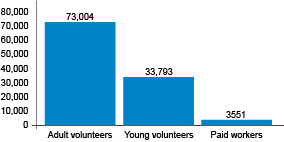Examining diversity
By now you will be aware that work with young people uses a variety of locations. However, you will also recognise that the diversity of settings is not simply about the building or other facility within which the work takes place. The difference between ‘settings’ might be represented in terms of a number of features that we can use to describe them:
- the location of the work
- the organisation that is responsible for the work
- the type of work that takes place there and its aim
- whether provision is part time or full time
- the role of the person/people doing the work
- employment arrangements – whether work is paid or unpaid, for example
- whether the setting receives funding and/or charges fees
- whether the setting needs to report to anyone else about what it does.
The next activity asks you to look at The Factory Project in the light of the features we have just listed.
Activity 2: Analysing a practice setting
To carry out this activity, you will look at two audiovisual ‘clips’ illustrating the work of ‘The Factory Project’, a youth work project in Loughborough, Leicestershire.
It is a detached youth work project for Asian young men who live locally. It aims to work with those aged 11–25 years of age, but with 80% of time and resources going to work with 13–19 year olds. The project was established in 2000 and aims to increase the active participation of Asian young men in the work of the Youth Service. It was founded by two detached youth workers and a small group of young people who met at a derelict warehouse, which gave the group its name.
The Factory Project seeks to:
- create space for young people
- provide opportunities
- establish challenges
- develop potential
- unleash creativity
- broaden horizons.
To do this the young people have taken part in lots of activities including discussions, debates, campaigning, health education workshops, outdoor pursuits, camping, visits to museums and places of interest, film-making and so on.
The first clip shows one evening’s work and in the second, Andrew, who manages the project, explains how he views it. In these clips, as well as Andrew, we see two part-time workers on the project, Akkas and Kasem. They were both originally participants in the project as young people.
As you watch, note down how you would describe the setting in terms of the features listed earlier in this course. You might find it helpful to use a table like the one below. (We have filled in our thoughts about the first feature to show you what we mean.)
(The content within Activity 2 including the videos is not subject to Creative Commons licensing.)
Transcript: The Factory Project clip 1: An evening with The Factory Project
[INTERPOSING VOICES]
[INTERPOSING VOICES]
[INTERPOSING VOICES]
[INTERPOSING VOICES]
[INTERPOSING VOICES]
[INTERPOSING VOICES]
[JAHANGIR RAPS]
Transcript: The Factory Project clip 6: Andrew’s perspective
[SIDE CONVERSATION]
[SIDE CONVERSATION]
| Feature | The Factory Project |
| The location of the work | The Factory Project takes place mainly in the street environment. |
| The organisation that is responsible for the work | |
| The type of work that takes place there and its aim | |
| Whether provision is part time or full time | |
| The role of the person/people doing the work | |
| Employment arrangements – whether work is paid or unpaid, for example | |
| Whether the setting receives funding and/or charges fees | |
| Whether the setting needs to report to anyone else about what it does |
Discussion
When we did this activity we filled our table in as follows:
| Feature | The Factory Project |
| The location of the work | The Factory Project takes place mainly in the street environment. |
| The organisation that is responsible for the work | The Factory Project is a project funded by the local authority. |
| The type of work that takes place there and its aim | The Factory Project aims to offer opportunities to, and raise the aspirations of, a group who make less use of youth provision than some others. |
| Whether provision is part time or full time | The project works at different times of the day and week to fit in with the lives and routines of the young people. |
| The role of the person/people doing the work | Andrew and his team are trained as youth workers. |
| Employment arrangements – whether work is paid or unpaid, for example | There appear to be paid and unpaid opportunities within this setting. It aims to ‘grow its own’ workers and train young people who participate. |
| Whether the setting receives funding and/or charges fees | The Factory Project started with a tiny budget but has succeeded in obtaining a large grant for a building. |
| Whether the setting needs to report to anyone else about what it does | The project carries out evaluation and it also needs to report to those who give funding. |
You and other readers of this course may have experience of different types of settings where there are different expectations. For example, some of you may spend time with young people primarily on a one-to-one basis, whereas others will work in group settings. Some of you may work with particular young people ‘targeted’ because of their perceived needs or problems, others will work in settings where young people can come and make use of the facilities during their leisure time. Some may work in youth clubs or centres, while others might engage in ‘detached’ work with young people on the streets.
An important distinction between settings concerns how much money they have to pay for activities and where it comes from. For example, funding may come predominantly from fees contributed by participants; alternatively, the setting may receive money from external sources such as the government, a charitable trust, donations from the public, or some mixture of all of these.

Often when a setting receives funding from an external source this means that those within the setting are required to work in a specified way (with particular young people, for example) and report to their funder on how successfully they have achieved this.
Readers of this course will also reflect the diversity of the sector through different patterns of engagement with young people. For example, if we consider employment patterns, there are many possibilities:
- you may be working with young people on a voluntary basis, with an organisation such as The Scout Association or St. John’s Ambulance. If so, you are likely to have other activities (such as work or domestic responsibilities) that occupy you for the rest of your time
- you may be working young people as a part of a different role – such as being a police officer or a firefighter
- you may be in the early stages of a career with young people
- you may not be working directly with young people at all but meeting them as part of the family or the local community.
Such differences in personal interest and outlook will affect your expectation of a setting and the setting’s expectations of you.
Interestingly, there is limited recorded evidence about the numbers of practitioners (paid and unpaid) who work with young people or the nature of what they do. Statistics that are available tend to measure certain parts of the sector. For example, YouthLink has measured the contribution made by different categories of worker to voluntary youth organisations in Scotland. These volunteers and paid staff work with a total of 386,795 young people, though the age range is wider than the 13–19 group that we are concentrating on in this course (37 per cent are under 10, 31 per cent are aged 10–14, 24 per cent are aged 15–17 and 8 per cent are aged 18–24.)

‘Adult’ volunteers are defined by YouthLink as those over 18 and ‘young’ volunteers as those under 25 who have helped on a short-term basis. What emerges clearly is the importance of voluntary workers to these organisations.
A similar picture emerges in other parts of the United Kingdom. In Northern Ireland:
there are at least 27,703 individuals involved in delivering and supporting youth work in Northern Ireland. This is more than the number involved in either the energy & water, or agriculture, forestry and fishing, sectors, in [Northern Ireland].
Within this workforce, 90 per cent are volunteers, most of whom are engaged in uniformed or church-based youth work; 8 per cent are part-time paid staff and 3 per cent are full-time paid staff.
In England:
The most recent figures suggest that there are around 5,500 [full time equivalent] youth workers employed by churches and Christian agencies, more than the statutory youth service … . There are also said to be around 100,000 volunteers. Churches have become the largest employer of youth workers in the country.
Overall, these statistics demonstrate that there are a large number of people who spend at least part of their time working with young people. However, the statistics are still incomplete. The next section concerns an attempt to audit a wider range of activity with young people in England.
